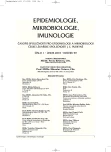Molekulární epidemiologie viru Varicella zoster
Molekulární epidemiologie viru Varicella zoster
Varicela zoster virus (VZV) se vyznačuje vysoce konzervativním genomem, obsahujícím přibližně 125 000 nukleotidových párů bází.
Článek přehledně shrnuje vývoj molekulárně genetických přístupů zkoumání VZV v průběhu posledních deseti let. Autoři se zabývají výstupy těchto metod, jako jsou fylogenetické vztahy mezi jednotlivými kmeny VZV, jejich virulencí, geografickou distribucí, možnými rekombinacemi.
Klíčová slova :
varicela zoster virus – DNA genom – genotypová analýza – single nuclotide polymorphism (SNP).
Autoři:
V. Boštíková 1
; P. Boštík 4; R. Chlíbek 1
; D. S. Schmid 2; M. Salavec 3; J. Smetana 1
; M. Špliňo 1
Působiště autorů:
Dpt. of Epidemiology, Faculty of Military Health Science, University of Defence, Hradec Králové, Czech Republic
1; Centers for Disease Control and Prevention, National Center for Immunizations and Respiratory Diseases, Atlanta, Georgia, USA
2; Dpt of Dermatology, Faculta Hospital, Hradec Králové, Czech Republic
3; Center of Advanced Studies, University of Defence, Czech Republic
4
Vyšlo v časopise:
Epidemiol. Mikrobiol. Imunol. 59, 2010, č. 1, s. 21-24
Souhrn
Varicela zoster virus (VZV) se vyznačuje vysoce konzervativním genomem, obsahujícím přibližně 125 000 nukleotidových párů bází.
Článek přehledně shrnuje vývoj molekulárně genetických přístupů zkoumání VZV v průběhu posledních deseti let. Autoři se zabývají výstupy těchto metod, jako jsou fylogenetické vztahy mezi jednotlivými kmeny VZV, jejich virulencí, geografickou distribucí, možnými rekombinacemi.
Klíčová slova :
varicela zoster virus – DNA genom – genotypová analýza – single nuclotide polymorphism (SNP).
Zdroje
1. Peters, G. A., Tyler, S. D., Gorse, C., Severini A. et al. A full-genome phylogenetic analysis of VZV reveals a novel origin of replication – based genotyping scheme and evidence of recombination between major circulating clades. J Virol 2006, 80, 9850-9860.
2. Rozenberg F., Lebon P. Amplification and characterization of herpes virus DNA in cerebrospinal fluid from patients with acute encephalitis. J Clin Microbiol 1991, 29, 2412-2417.
3. Clark P., Davidson, D., Letts, M., Lawton, L. et al. Necrotizing fasciitis secondary to chickenpox infection in children. Can J Surg 2003, 70, 961-963.
4. Arvin A. M. Varicella-zoster virus: overview and clinical manifestations Semin. Dermatol. 1996, 15, 4-7.
5. Norberg P., Liljeqvist, J. A., Bergstrom, T., Sammons, S. et al. Complete-genome phylogenetic approach to VZV evolution: Genetic divergence and evidence for recombination. J Virol 2006, 80, 9569-9576.
6. Dayan G. H., Panero, M. S., Debbag, R., Urquiza A. et al. Varicella seroprevalence and molecular epidemiology of varicella-zoster virus in Argentina. J Clin Microbiol 2004, 42, 5698-5704.
7. Loparev V. N., Gonzalez, A., Deleon-Carnes, M., Tipples, G. et al. Global identification of three major genotypes of VZV: longitudinal clustering and strategies for genotyping. J Virol 2004, 78, 8349-8358.
8. Sergeev N., Rubtcova, E., Wutzler, D., Schmid, S. D. et al. New mosaic subgenotype of varicella-zoster virus in the USA. VZV detection and genotyping of oligonucleotide-microarray. J Virol Methods 2006, 136, 8-16.
9. LaRussa P. S., Steinberg, S. P., Shapiro, M., Vazquez, M. et al. Viral strain identification in varicella vaccines with disseminated rashes. Pediatr Infect Dis J 2000, 19, 1037-1039.
10. Lolekha S. W., Tanthiphabha, P., Sornchai, P., Kosuwan, P. et al. Effect of climatic factors and population density on varicella zoster virus epidemiology within a tropical country. Am J Trop Med Hyg 2001, 64, 131-136.
11. LaRussa P. S., Lungu, O., Hardy, I., Gershon, A. et al. Restriction fragments length polymorphism of polymerase chain reaction products from vaccine and wild-type varicella-zoster virus isolates. J Virol 1992, 66, 1016-1020.
12. Loparev V. N., Rubtcova, E., Seward, M., Levin, M. et al. DNA sequence variability in isolates recovered from patients with postvaccination rash or herpes zoster caused by Oka varicella vaccine. J Infect Dis 2007, 195, 802-810.
13. Loparev V. N., et al. Distribution of varicella-zoster virus (VZV) wild-type genotypes in northern and southern Europe: evidence for high conservation of circulating genotypes. Virology 2009, 383, 216-225.
14. Loparev V. N., Rubtcova, E. N., Bostik, V., Govil, D. et al. Identification of five major and two minor genotypes of varicella-zoster virus strains: a practical two-amplicon approach used to genotype clinical isolates in Australia and New Zealand. J Virol 2007, 81, 12758-12765
15. Barret-Muir W., Scott, F. T., Aaby, P., John, J. et al. Genetic variation of varicella-zoster virus: evidence for geographical separation of strains. J Med Virol 2003, 70, Suppl 1, S42-47.
16. Loparev V. N., Martro, E., Rubtcova, E., Rodrigo, C. et al. Toward universal varicella-zoster virus (VZV) genotyping: diversity of VZV strains from France and Spain. J Clin Microbiol 2007, 45, 559-563.
17. Wagenaar T. R., Chow, V. T., Buranathai, C., Thawatsupha, P. et al. The out of Africa model of varicella-zoster virus evolution: single nucleotide polymorphisms and private alleles distinguish Asian clades from European/North American clades. Vaccine 2003, 21, 1072-1081.
18. Sauerbrei A., Wutzler P. Different genotype pattern of varicella-zoster virus obtained from patients with varicella and zoster in Germany. J Med Virol 2007, 79, 1025-1031.
19. LaRussa P., Gerson A. A. Biologic and geographic differences between vaccine and clinical varicella-zoster virus isolates. Arch Virol Suppl 2001, 41 -48.
20. Faga B., Maury, D. A., Bruckner, D. A. and Grose, C. Identification and mapping of single nucleotide polymorphisms in the varicella-zoster virus genome. Virology 2001, 280, 1-6.
Štítky
Hygiena a epidemiológia Infekčné lekárstvo MikrobiológiaČlánok vyšiel v časopise
Epidemiologie, mikrobiologie, imunologie

2010 Číslo 1
- Parazitičtí červi v terapii Crohnovy choroby a dalších zánětlivých autoimunitních onemocnění
- Očkování proti virové hemoragické horečce Ebola experimentální vakcínou rVSVDG-ZEBOV-GP
- Koronavirus hýbe světem: Víte jak se chránit a jak postupovat v případě podezření?
Najčítanejšie v tomto čísle
- Životní jubileum prof. MUDr. Vladimíra Janouta, CSc.
- Nocardia farcinica jako původce abscesu mozku u pacienta s intersticiálním onemocněním plic
- Výskyt tularémie na Slovensku v rokoch 1997 – 2008
- Exotickí domáci miláčikovia ako potenciálny zdroj salmonel
